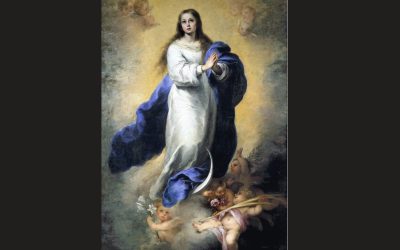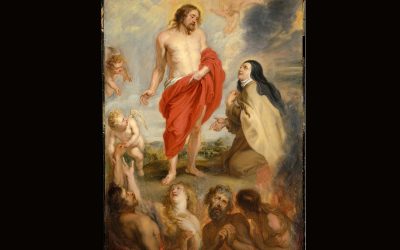By Amber Kinloch & Rose Leigh
To proclaim that the Catholic Church is “One” is to set yourself up for a barrage of questions.
“One?” an objector might exclaim. “Are you kidding me? Look at you Catholics! You’ve got traditionalists, charismatics, and all these different religious orders, rites, and liturgies. Some Catholics support abortion while others oppose it. You have one Pope saying this and another saying that. And yet you all call yourselves Catholic. How can you all be “One”?
These objections are reasonable and well deserving of answers. First, however, we must explain what we mean by “One.” According to the Baltimore Catechism No. 3:
“The Catholic Church is One because all its members, according to the Will of Christ, profess the same faith, have the same sacrifice and sacraments, and are united under one and the same visible head, the Pope” (Question 156).
Let’s examine what this means in detail. (And though we can’t cover every issue, we’ve included plenty of links for further reading.)
The Will of Christ
It is clear from Sacred Scripture that Christ desires that the Church He establishes be One. In speaking of Himself as the Good Shepherd, He says: “I have other sheep that do not belong to this fold. These also I must lead, and they will hear my voice, and there will be one flock, one shepherd” (John 10:16).
At the Last Supper, He prays: “And now I will no longer be in the world, but they are in the world, while I am coming to you. Holy Father, keep them in your name that you have given me, so that they may be one just as we are” (John 17:11).
God desires unity for His Church, and why? Because it is an essential part of Who He is. Our God is a Trinitarian God. He is three distinct Divine Persons, and yet one God. The Church, then, if it is truly His, must be one.
The Same Faith
How can Catholics profess to be one in faith? We frequently hear Catholics disagreeing on major political issues, and many people say they are Catholic but don’t believe in certain Church teachings. If the Church shares one faith, how can there be disagreements?
First, it’s important to remember that the Church’s teachings come from God, handed down from the apostles (another mark of the Church). The Faith is not a human invention, and the Catholic Church is not composed of a body of freethinkers. Therefore, if someone wants to become Catholic, believing in Catholic teaching is a prerequisite. It’s not the other way around—God’s truth doesn’t conform to what humans think it should be.
I occasionally see a bumper sticker in traffic that reads: “U Can’t Be Catholic and Pro-Choice.” It’s true. If somebody calls themselves Catholic but skips Mass on Sundays (without serious cause) or supports abortion or denies the need for Baptism for salvation, they are not truly following the Catholic Faith.
That said, there are a multitude of issues on which the Church offers guidance, but no black-and-white answers. Thus, faithful Catholics can hold a variety of positions when it comes to issues like economics, immigration, evolution, or how to practice charity towards the poor. However, all Catholics are called to believe in the same guiding principles on these issues, even if they may have different ideas on how to apply them practically.
The Same Sacrifice and Sacraments
How is it that Catholics can profess the same faith and yet have such a range of rites (Byzantine, Alexandrian, Latin), religious orders (Franciscan, Carmelite, Dominican), traditions, etc.? Wouldn’t it be simpler if all Catholics worshiped and followed God in the same way? Don’t these differences produce unnecessary division and threaten the Church’s unity?
The short answer is “no.” Unity does not equal uniformity, as anyone who’s observed a family might tell you. The members of a family might possess a wide range of personalities, talents, and tastes, and yet still maintain a strong bond among themselves as a family. So it is with the church.
“Within the unity of the People of God, a multiplicity of peoples and cultures is gathered together. … ‘Holding a rightful place in the communion of the Church there are also particular Churches that retain their own traditions.’ The great richness of such diversity is not opposed to the Church’s unity” (CCC 814). On the contrary, it is a gift.
The language and ceremonies used in the offering of the Mass and the administration of the sacraments might be different, but the essential parts are the same. Thus we might have a multiplicity of rites, religious orders, etc., while at the same time maintaining unity. And so everywhere “from the rising of the sun to its setting, a pure sacrifice” is offered to God (Eucharistic Prayer III, citing Malachi 1:11).
One and the Same Visible Head
The Catholic Church has a final bond of unity in the form of her one head, the Pope, the Vicar of Christ and the successor of St. Peter.
Some may ask: Why the need for a Pope? We can all manage well enough without one, can’t we? Except we can’t. Christ founded a visible church, one in need of visible leadership. Without this leadership, we’d all be left groping for the truth. In short order, we’d fall into error and division, with no one sure of the truth. (Exactly what has happened with Protestantism and its tens of thousands of factions.)
Hence, Jesus builds His Church upon the rock of Peter (Matthew 16:19). Peter, in turn, passes this power and authority on to his successors as Jesus surely intended. Jesus, after all, wills that the Church is to last until the end of time. But how could that be without continuing leadership down through the ages?
Now, this doesn’t mean that leadership is perfect. Popes can be great sinners. Though they can teach infallibly, that does not mean they are without sin. Nor do they always teach infallibly. That is actually rare. Usually, they teach in ordinary ways, such as through letters and encyclicals. Catholics accept such teachings “not on faith, but in obedience to the authority of the Pope and out of respect for his wisdom” (Baltimore Catechism No. 3, explanation for Question 164).
This is only a brief overview of the papacy. If you’d like to read more, check out “Defending the Papacy” by Trent Horn from Catholic Answers, along with the other links above.
Next up, we’ll examine why the Church is holy!

Amber Kinloch
Amber writes from the bunker of her living room. There she hunkers down with her laptop and a blanket while keeping an eye and ear tuned in to the activity of family life. Music set on loop keeps her energy flowing as she muses on the deeper happenings of ordinary life and what food to restock the fridge with.

Rose Leigh
Rose has been drawing and writing since she could hold a pencil, creating worlds of giants, fairies, and adventurers from her imagination. She works as a graphic designer and loves discussing the good and creative aspects of literature, art, and film.






0 Comments